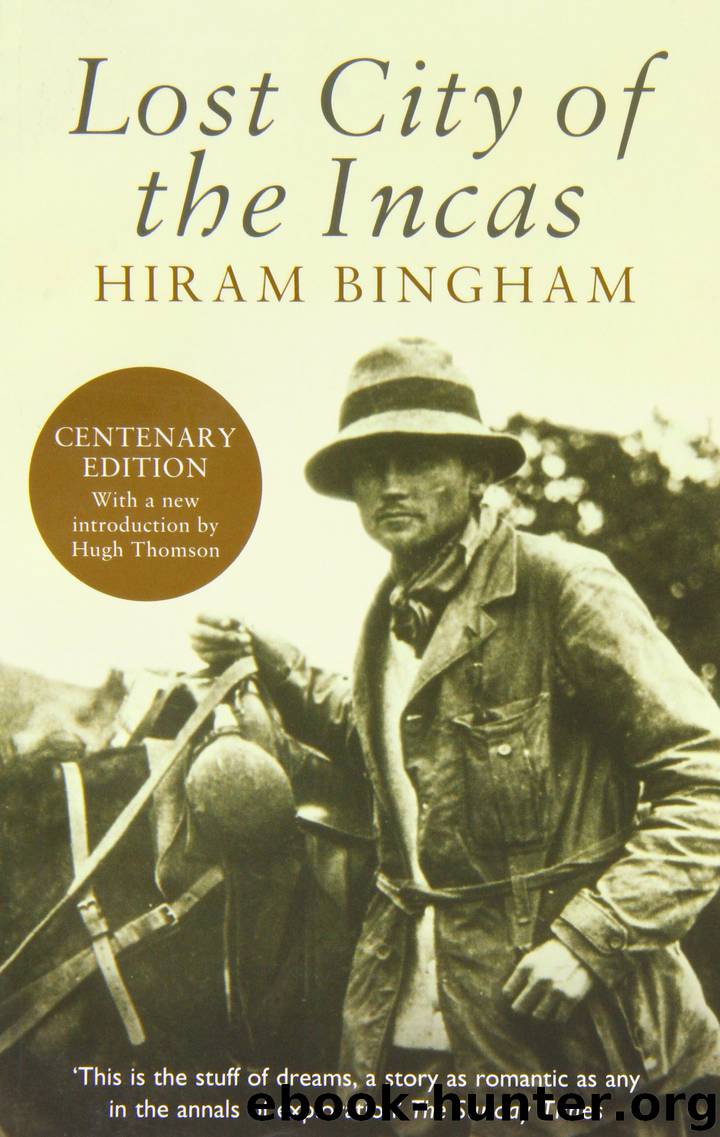Lost City of the Incas (Phoenix Press) by Hiram Bingham

Author:Hiram Bingham [Bingham, Hiram]
Language: eng
Format: epub, mobi
ISBN: 9780297865339
Publisher: Hachette Littlehampton
Published: 2015-07-17T16:00:00+00:00
So we went back up the Hill of Roses to make further studies and to do some excavating.
On the south side of the hilltop, opposite the long palace, is the ruin of a single structure, 78 feet long and 25 feet wide, containing doors on both sides, no niches, and no evidence of careful workmanship. It may have been a barracks for Manco’s soldiers, but the absence of any niches leads me to believe that it was built by Manco’s order for the Spanish soldiers who had fled from Cuzco and taken refuge with him. Another reason for my belief is that between this building and the palace is a pampa which might have been the scene of those games of bowls or quoits, which were played by the Spanish refugees. Here may have occurred that fatal game when one of the players lost his temper and killed his royal host.
Our excavations yielded a mass of rough potsherds, a few Inca whirl-bobs, and bronze shawl-pins, and also a number of iron articles of European origin, heavily rusted horseshoe nails, a buckle, a pair of scissors, several bridle or saddle ornaments, and three jews’ harps. My first thought was that modern Peruvians must have lived here at one time, although the necessity of carrying all water supplies up the steep hill would make this unlikely. Furthermore, the presence here of artifacts of European origin does not of itself point to such a conclusion. In the first place, we know that Manco was accustomed to making raids on Spanish travellers between Cuzco and Lima. He might very easily have brought back with him a Spanish bridle. In the second place, the musical instruments as well as the saddle ornaments may have belonged to the refugees, who might have enjoyed whiling away their exile with melancholy twanging. In the third place, the retainers of the Inca probably visited the Spanish market in Cuzco, where there would have been displayed at times a considerable assortment of goods of European manufacture. Finally, Rodriguez de Figueroa speaks expressly of two pairs of scissors he brought as a present to Titu Cusi. That no such array of European artifacts has been turned up in the excavations of any other important sites in the province of Vilcapampa would seem to indicate that they were abandoned before the Spanish Conquest or else were occupied by natives who had no means of accumulating such treasures.
All our expeditions in the ancient province of Vilcapampa have failed to disclose the presence of any other ‘white rock over a spring of water’ surrounded by the ruins of a possible ‘House of the Sun’. Consequently it seems reasonable to adopt the following conclusions: Ñusta Isppana is the Yurak Rumi of Father Calancha. The Chuquipalta of today is the place to which he refers as Chuquipalpa. This is the ‘Viticos’ of Cieza de Leon, a famous military chronicler, a contemporary of Manco, who says that it was to the province of Viticos that Manco determined
Download
Lost City of the Incas (Phoenix Press) by Hiram Bingham.mobi
Lost City of the Incas (Phoenix Press) by Hiram Bingham.epub
This site does not store any files on its server. We only index and link to content provided by other sites. Please contact the content providers to delete copyright contents if any and email us, we'll remove relevant links or contents immediately.
| Argentina | Bolivia |
| Brazil | Chile |
| Colombia | Ecuador |
| Guyana | Paraguay |
| Peru | Suriname |
| Uruguay | Venezuela |
Cat's cradle by Kurt Vonnegut(13856)
Pimp by Iceberg Slim(12923)
Underground: A Human History of the Worlds Beneath Our Feet by Will Hunt(11251)
4 3 2 1: A Novel by Paul Auster(11033)
The Radium Girls by Kate Moore(10901)
American History Stories, Volume III (Yesterday's Classics) by Pratt Mara L(4821)
Perfect Rhythm by Jae(4616)
Wiseguy by Nicholas Pileggi(4581)
The Fire Next Time by James Baldwin(4336)
Paper Towns by Green John(4163)
A Higher Loyalty: Truth, Lies, and Leadership by James Comey(4024)
Pale Blue Dot by Carl Sagan(3996)
The Mayflower and the Pilgrims' New World by Nathaniel Philbrick(3905)
The Doomsday Machine by Daniel Ellsberg(3725)
Too Much and Not the Mood by Durga Chew-Bose(3689)
Killers of the Flower Moon: The Osage Murders and the Birth of the FBI by David Grann(3604)
The Borden Murders by Sarah Miller(3581)
The Sympathizer by Viet Thanh Nguyen(3466)
Sticky Fingers by Joe Hagan(3449)
